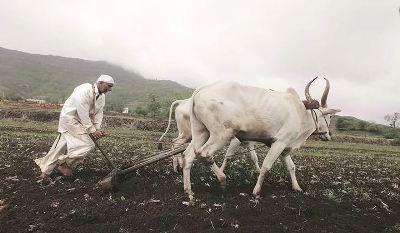Finance Minister of India Nirmala Sitharaman presented an idea of zero budget farming at the lower house of parliament during her budget speech in the 17th Lok Sabha in July this year, urging the farmers of this nation to go back to 'basics', an ancient Indian practice. Sitharaman, an economics scholar, elaborated her thought behind the move to the speaker and the house. She focuses on boosting the income of farmers to help them get rid of their current shabby conditions, an agrarian crisis where farmers spending more than that of their earnings which put them in neck-deep debt.
With nowhere to go farmers are committing suicides across the nation. However, a few states took the situation in their hands to overhaul the system. Southern states Karnataka and Andhra Pradesh have been bringing a paradigm shift in agriculture sector going back to basics, a Vedic practice.
What is ZBNF?
ZBNF stands for (Zero Budget Natural Farming) which in other word is organic farming. Over time, India farmers have been finding it difficult to deal with neo-liberalization of the Indian economy. High production costs, high-interest rates on loans, an opaque market system in which farmers are hardly making a profit selling their products, ever-rising price of fossil fuel, acute rains, privatization of fertilizers, pesticides and seeds put farmers in a cruel cycle of debt.
A way out from such unfriendly conditions was required to improve the health of the foundation of Indian economy, agriculture. ‘Zero budget’ vows to cut the production costs ending desperate farmers’ dependency on bank loans.
The technique makes best uses of household ingredients, dismissing the conventional farming that is highly reliant on chemical fertilizers and pesticides. Nevertheless, ZBNF has the noble motive of empowering farmers helping them get rid of the prevailing situation. The phrase ‘zero budget’ refers to zero investment in household ingredients. The term ‘natural farming’ invokes the idea of treating nature with care. Hence, it urges farmers to end the use of chemicals.
Who propagated the idea of first?
The ZBNF technique is first propagated by Shubhash Palekar in the mid-1990s, who hails from Vidarbha, the worst affected area of privatization of agriculture market, as an alternative to the Green Revolution’s methods which focus on high production using chemical fertilizers and pesticides and intensive irrigation.
He says the rising cost of external contribution is the reason behind indebtedness and suicide among farmers. At the same time, agriculture is being practised at the cost of the environment as the use of chemicals could be devastating for the fertility of the soil. Moreover, his idea of farming will show small scale farmers a way out from the debt cycle.
According to the National Sample Survey Office (NSSO) data, almost 70% of agricultural households are not getting profit from the usual farming. More than 50 per cent of farmers is in neck-deep debt. When it comes to Andhra Pradesh and Telangana the level of indebtedness is around 90 per cent, each agriculture household bears an average debt of Rs 1 lakh. Central government pledges to beef up farmers’ income by 2022.
Basics of the system
Palekar is a vocal critic of chemical fertilizers. He produced a homemade fertilizer ‘Jeevamrutha’ as a replacement of commercially produced fertilizers. ‘Jeevamurtha is a mixture of fresh indigenous cow dung, restored cow urine, jaggery, pulse flour, water and soil. This mixture adds nutrients to the soil and it plays a major role in promoting the activity of microorganisms and earthworms in the soil. Only one cow is required for 30 acres of land, Palekar said adding that it must be a local Indian breed, not a Jersey or Holstein.
Apart from ‘Jeevamrutha’, the farmers need to prepare ‘Bijamrita’ to treat seeds. Neem leaves, pulp, tobacco and green chillis are required to compose ‘Bijamrita’ for insect and pest management.
How many formers using this method?
According to the Economic Survey, more than 1.6 lakh farmers adapted to the practice of ZBNF in 1,000 villages. Most of these farmers are getting some kind of support from their respective states. However, NITI Aayog claimed the estimated number of farmers using the technique is 30 lakh.
Budgetary support
In 2018, Rashtriya Krishi Vikas Yojana- Remunerative Approaches for Agriculture and Allied sector Rejuvenation (RKVY-RAFTAAR) allocated Rs 3,745 crore to the agriculture sector for the Green Revolution programme. Out of which the ministry allocated Rs 325 crore to organic farming.
Andhra Pradesh used Rs 249 crore from the RKVY-RAFTAAR scheme to promote ZBNF in the state over a two-and-a-year period. The state government said that they would require another Rs17,000 to help its 60,000 farmers switch to the Vedic practice.
What could be its implications?
However, question remains on the effectiveness of ZBNF. A study conducted in Andhra Pradesh in 2017 noted that there was a sharp decline in production. Reportedly, many farmers, including the natives of Palekar in Vidarbha, switched to conventional farming finding less profit from the system. Undoubtedly, the report questions the practicality of the technique in doubling farmers’ incomes, the main point of Sitharaman’s budget speech.
Could it be an alternative to the Green Revolution?
The critics of the method, that includes some experts of NITI Aayog, the policy and planning think tank of the Indian government, warned the government saying it could be a disaster for India if it entirely switches to ZBNF from Green Revolution. It must be noted that it is the Green Revolution that helps India to be self-sufficient and ensures food security of every Indian citizen still today.
Sitharaman’s ministry must take note of Sikkim, which has observed a sharp drop in production following its adaptation to organic farming, as a consultative review regarding the downside of abandoning chemical fertilizers and pesticides.
What is way forward?
Analysing reports and incidents from several states NITI Aayog, the principal advocate of Palekar’s technique of farming, said that multi-location researches are required to find out the financial and scientific viability of ZBNF before the formal implementation of it across the country.
Currently, the Indian Council of Agricultural Research (ICAR) is examining the method practised by bastami and wheat farmers in Modipuram (Uttar Pradesh), Ludhiana (Punjab), Pantnagar (Uttarakhand) and Kurukshetra (Haryana). ICAR will assess its impact on output, financial conditions of farmers and soil fertility level.
If the research found the method successful, an institutional mechanism could be formed to encourage farmers to take up the technology, NITI Aayong’s vice-chairman Rajiv Kumar said. Karnataka and Andhra Pradesh experiences are also being monitored to review the level of financial and technical assistances farmers needed from the government.
Apart from ICAR, a team scientists at the GB Pant University of Agriculture and Technology is investigating various crops applying ZBNF technique. The methods would be used to grow seven crops including wheat, moong (green gram), chana (chickpeas) and methi (fenugreek).
By Sudipta Biswas: The writer has a passion for agriculture journalism and can be contacted on agritimesindia[@]gmail[DOT]com




















